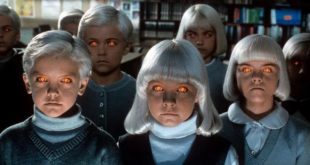28 Days Later… first graced American screens 15 years ago this month. I remember it vividly because my wife and I were expecting our first child, and I’m sitting there thinking that it’s either going to scar him in utero or give him an unexplainable affinity for horror. Well, neither one of those things has happened yet (I think). Fifteen years later, I have a moody teenager who peers up from his phone every two hours or so, and Danny Boyle’s film about panic in the streets of London has gone on to become one of the new horror classics.
It seemed like 28 Days Later… came out of nowhere at the time. The horror genre was in a transitional flux while it adjusted from the lull of the early 90s to the shot in the arm from stuff like Scream and The Faculty in the mid to latter part of the decade. It was post-Kevin Williamson and pre-polished horror classic remakes, and the found footage dynasty was just gaining a foothold. So an apocalyptic horror flick from the guy that made Trainspotting was the last thing anyone saw coming or even thought they needed at the time. Yet, what it did was not only pay homage to those contagion and zombie classics of the past, but it cut some new ruts of its own.

The film starts as Jim (Cillian Murphy) wakes up from a coma and finds the bustling London that he knew beforehand absolutely deserted and desolate. It had been a while since we had seen anything like that opening scene. It wasn’t the first to feature a dude waking up in a hospital after the world has spiraled into bedlam. The first that I know of was The Day of the Triffids (1963), and then, of course, when The Walking Dead’s Rick Grimes wakes up to the aftermath of a zombie apocalypse. All three films are exceptional at capturing that feeling of disorientation after waking up, the panic of a changed environment, and the empathetic omniscience of the viewer. They know that eventually, that poor person is going to run across what caused all this trouble, and it’s not going to be pretty.
When Jim opens his eyes, it introduced modern audiences to how sleeping through the first wave of carnage is more of a curse than a blessing. No information, a necessity to trust questionable survivors, and a lack of closure for the fate of one’s family creates an automatic character arc that plays so well with the plethora of social ramifications that comes with the collapse of the civilized world.

The film also sparked discussions on what a zombie really is. After the success of 28 Days Later…, Zack Snyder’s Dawn of the Dead, and Shaun of the Dead, there seemed to be so many directions in which to go. Run or walk, smart or stupid, dead or infected… everyone had an opinion. As a matter of fact, the well almost went dry due to an oversaturation of interpretation. 28 Days Later… is a contagion film, but really what attracts anyone to a zombie-ish theme is an unstoppable plague, the frailty of human nature, and hordes of murderous monsters that used to friends, family, and lovers. Zombies have no natural enemies… garlic doesn’t harm them and silver bullets won’t kill them. They don’t need to feed on anything to keep going, so starving them out is not an option. After all, Zombieland is a contagion film, too. I watched Cronenberg’s Rabid again recently, and I realized how close it was to those blurred lines.

In the end, 28 Days Later… ended up being one of those films that people started talking about, recommending, and debating. It shaped modern horror in the 2000s. Give it a re-visit this month. as a matter of fact, the sequel is always good for a double feature as well.
 PopHorror Let's Get Scared
PopHorror Let's Get Scared




